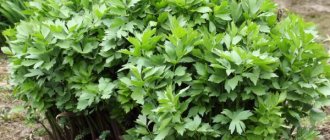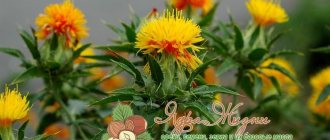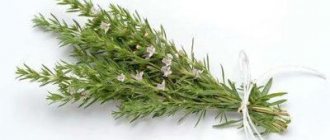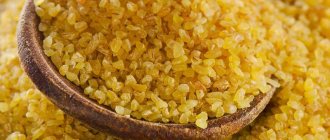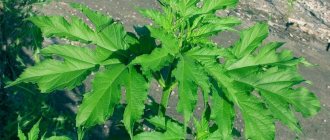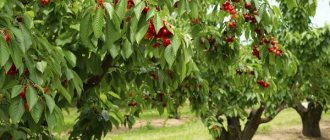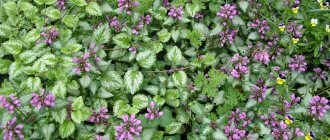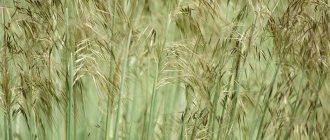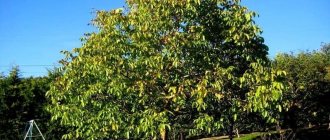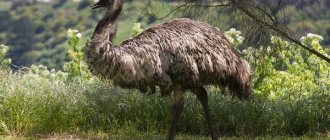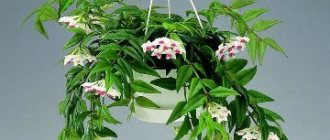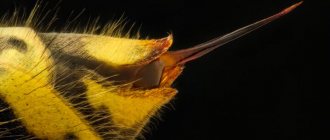Perilla stands out for its beautiful foliage color and serves as a garden decoration.
Perilla
Perilla is actively used in landscape design, cooking, folk medicine and cosmetology. In terms of carotene content, perilla is not inferior to carrots, and the amount of omega acids in the plant oil is 2 times higher than fish oil.
Description and composition
Perilla bush is a classic perennial. Perilla has a hard time surviving frosts, so in regions with a frosty climate this plant is an annual.
The lower leaves of perilla reach 10 cm in length, the standard height is 35-60 cm, but there are specimens up to 1 meter high.
Perilla leaves have an oblong shape and are arranged oppositely. The flowers bloom at the top of the stem and resemble bells.
The plant is represented by the following varieties:
- Vegetable perilla. At a quick glance, it resembles basil, but its leaves are noticeably larger. The type of plant determines the smell emanating from it. Most often the aroma resembles basil, mint or cinnamon. The fruits are used to produce seasonings;
- Perilla bush. The main purpose of cultivation is the seeds, from which essential oils are subsequently produced.
The beneficial properties of this plant are determined by its chemical composition:
- An impressive concentration of vitamin C helps strengthen the immune system;
- Perilla contains provitamin A in the same amount as carrots;
- This plant also contains provitamins of group B, which strengthen and heal the nervous system;
- vitamin PP lowers cholesterol and optimizes metabolic processes in the body;
- minerals are represented by magnesium and potassium, calcium and iron;
- the concentration of omega 3 acids exceeds that in fish oil;
In addition, the overall aging of the body is slowed down by antioxidants, which are also present in perilla.
Perilla is a plant that contains a large amount of useful substances
Transplanting seedlings into soil
The soil for growing the plant must be waterproof and loose. It is best if beans or peas previously grew on the site. In the fall, you need to add rotted compost to the site, and in the spring - complex mineral fertilizer.
In early June, you can plant perilla in open soil. The planting density is 25 bushes per m2. The plant tolerates replanting normally, as it is completely unpretentious in care. It is important to provide proper care for the perilla plant, which means:
- watering;
- loosening;
- feeding;
- weeding;
- pinching.
A small amount of chicken manure is good for feeding. It needs to be scattered under the bushes of the plant. Perilla normally tolerates summer heat and drought, but it is advisable to carry out periodic watering, preventing the soil from drying out too much. The optimal temperature is 22-28 degrees. An adult plant does not tolerate low temperatures very well. However, it is worth remembering that in extreme heat, petals and unripe seeds may also fall off.
If the plant is short, then periodically pinch the top of the bush, and for tall bushes a decorative pruning is required. This allows for much greater bushiness. Perilla tolerates pruning very well. Low-growing varieties, whose height is no more than 50 cm, are especially highly valued. They can be used as beautiful border plants.
They begin to harvest greens at the beginning of flowering. The shoots are cut to a height of approximately 10 cm from the surface of the earth. During the season, mainly 2 cuttings are carried out. Depending on the growing conditions of the plant, the average yield per m2 is approximately 0.5-5 kg.
Fresh greens can be stored for 7 days if you put them in a glass, hermetically sealed jar and put them in the refrigerator. It is not recommended to store it in a plastic bag, as the plant will rot in this case. For long-term storage of greens, various preparations are made from it.
Botanical description
The plant has an erect stem of 4 sides; it does not branch.
Perilla leaves are heart-shaped and wrinkled.
The most popular varieties are those with a long growing season.
In some cases, 5 months pass from planting to flowering.
The formation of flower stalks occurs in the fall, when the length of daylight hours decreases.
perilla leaves
The healing properties of perilla
Essential and fatty oils of perilla can boast of pronounced therapeutic properties. Infusions and decoctions are made from leaves and seeds, the effect of which can be:
- painkillers;
- antiseptic;
- calming;
- sweatshop;
- diuretic.
Ready-made products help get rid of:
- cough;
- bronchitis;
- colds.
In addition, perilla leaves contain oils with a high concentration of alphalinoleic acid, which is vital for the human body at any age.
Linoleic and oleic acids are also present in the oil from the leaves of this plant.
Perilla bush produces oils, the use of which allows you to achieve the following results:
- Prevention and treatment of dermatological diseases.
- Reducing cholesterol.
- Normalization of blood pressure in hypertensive patients.
- Fighting inflammatory processes affecting joints.
Perilla contains tannins and phenolic compounds, which have anti-inflammatory, antiviral, and antibacterial effects.
This herb includes rosmarinic acid, which protects the skin from sun damage.
Perilla leaves are widely used in cosmetology. Their oil moisturizes and nourishes the skin, helps localize and heal irritation processes and improve the overall condition of the skin . The creams and face masks that perilla “gives us” are traditionally very popular.
Perilla has a wide range of medicinal effects
Perilla varieties
Perilla is known for its relatively small variety of varieties. The unusual taste has made the perilla vegetable plant, also known as Nanjing, truly popular.
The plant is very popular in the following varieties:
- Dewdrop. Frost-resistant, fast-ripening variety with red leaves. This perilla was bred by domestic breeders.
- Akashiso. Distinctive features are the aroma of pepper and red leaves.
- Red mint. Perilla of this variety is distinguished by the pimpled structure of its leaves. The plant of this variety exudes the smell of cinnamon, lemon and mint.
- Aoshiso. The plant of this variety always has green leaves and surrounds itself with a stunning bouquet of anise and caramel smells.
- Perilla bush (basil). Perhaps the only variety whose stem height reaches 140 centimeters. This variety has ovoid perilla leaves. Despite the pungent odor, perilla leaves are often eaten . Seeds are the main value of this variety.
Perilla of different varieties
Culinary uses of the plant
The juicy and tender greens of this plant have many shades of tastes and aromas. A light peppery note in the taste is combined with aromas and. Perilla can be used in dishes, both fresh and pickled, salted or dried.
For sauces and all kinds of drinks, it is better to use pickled herbs, but as a spice for meat or stewed vegetables, powder from dry leaves is better suited. The spice is produced from green leafy varieties of perilla. Red-leaved varieties are used in all kinds of preparations and marinades. The plant gives not only an unforgettable taste to pickles, but also a rich color. For example, when pickling stachis, you can use red perilla, as is often done in Japan. The tubers of the plant, thanks to the red-leaved culture, become pinkish and acquire an unusual taste and aroma.
Reproduction methods
The most popular option is propagation by seeds. It is possible to sow directly into the ground, but planting as seedlings is also quite popular.
If you prefer the first option, then planting should be planned in the fall or early spring, in March.
Planting in open ground is practiced mainly in the southern regions. If we are talking about regions with a temperate climate, then a reasonable solution would be to grow seedlings and only then plant them in open ground.
Before planting seedlings, perilla seeds are soaked in a weak solution of potassium permanganate (the water should be warm) for 2 days.
After the specified period, the seeds are sown in sandy-peat soil. The optimal seed depth is 5 mm. After sowing, the soil surface should be moistened with a spray bottle and covered with film.
The first shoots should be expected in about 20 days.
It is important to carry out periodic thinning and cover the soil surface with a thin layer of sand. Planting in open ground should be done after several full leaves appear. As a rule, this happens in early or mid-May.
Perilla seeds
Use of perilla in cooking
Perilla greens have a mild anise and lemon aroma, and the taste is juicy and tender, with a slight peppery taste. The leaves of young plants are used mainly fresh. The leaves are also pickled, salted and added when preparing various drinks and sauces.
A powder is made from dry perilla leaves, which is used as a spice, adding to vegetable and meat dishes. Green leafy plant varieties are mainly used as a spice.
Red-leaved varieties are added to all kinds of pickles to give them color. In Japan, for example, red-leaved perilla is added when salting stachys. At the same time, stachys tubers acquire a subtle specific aroma and a beautiful pink-red hue.
Methods of application
Perilla is popular as a raw material for oil production. The plant and its seeds contain up to 45% oil, which is used to make paint and varnish products, as well as waterproof fabrics.
Use in folk medicine
The therapeutic effects of the plant are widely used in a number of pathological conditions:
- Perilla shoots and leaves serve as the basis for a diaphoretic decoction; they are often used in powder form. The leaves are crushed to a powder structure, and then 1 tablespoon is poured with 200 ml of boiling water and cooked over low heat in a container with a lid for 5 minutes. After the specified time, the finished mixture is infused for half an hour and filtered, then taken a third of a glass three times a day.
- Perilla is also useful in the fight against digestive disorders.
- Perilla leaves are also an effective medicine for bronchitis; they are used as an expectorant. Seeds in the amount of 1 tablespoon or 5 tablespoons of thoroughly dried raw materials are poured with 500 ml of water and boiled for a quarter of an hour, and then left for at least 2 hours. Take 100 grams 5 times a day.
Perilla is also effective against leprosy, diarrhea, and seafood poisoning.
Perilla is an excellent diaphoretic
Application in cosmetology
Perilla provides hydration, healing and rejuvenating effects and is therefore actively used in cosmetology.
The plant produces oils and extracts, on the basis of which they produce:
- UV protection creams;
- creams and tonic essences for dry and elastic skin;
- wrinkle smoothing products;
- solutions for skin care after shaving;
- hair care products.
Perilla oil is good for skin
Perilla in cooking
The stems and leaves of perilla can boast the aroma of lemon and anise, and the taste is always “juicy”, rich.
In most cases, perilla leaves are used fresh, avoiding freezing and preservation.
Dried perilla leaves are ground and used as a seasoning for meat dishes and vegetables.
Some varieties are used as an ingredient for winter preparations.
With their help, they achieve an appetizing smell, and the color of the preparations also turns out to be characteristic.
Perilla is actively used in dishes
Plant care
The optimal temperature at which perilla will develop correctly is +18 +27 degrees. At temperatures above this maximum, watering frequency should be increased.
If you want the plant to survive in the autumn-winter period, it should be moved to a greenhouse.
The optimal frequency of watering is 3 times a week. During the hot season, perilla is watered only in the evening, otherwise the plant risks “burning out.”
Fertilizing with organic fertilizers should be done at least once every 30 days; it is permissible to use compost and chicken manure.
The first cutting is carried out upon reaching a height of 10 cm. Harvesting - 2 times per season . Perilla does not tolerate stagnant water, dampness, or cold.
How to grow perilla
In most cases, perilla is grown from seeds. Water the seedlings at least once every 14 days and do this with a spray bottle. Seedlings need to be loosened at least once every 2 weeks.
Procurement of raw materials
The leaves and stems are collected before the perilla blooms. Anything above 10 centimeters from the soil should be cut off.
The maximum shelf life of fresh leaves is no more than a week, in tightly closed jars, in the refrigerator.
You should not store perilla leaves in bags, because this often leads to the formation of mold. If it is necessary to make a supply, then the perilla is dried and ground into powder; in this state it will be suitable for decoctions even after several months.
Perilla leaves for harvesting
Landing Features
The soil for planting is prepared in the fall. Preparation includes digging and adding compost.
The soil structure must be loose to ensure air circulation. Ideally, the soil should be after peas or other legumes, then the perilla will grow very well.
With the onset of spring, it is worth adding mineral fertilizers to the holes. A sure signal for the need for immediate planting is an average daily temperature of at least +10 degrees.
The distance between bushes is not less than 20 and not more than 30 cm.
As in the case of seedlings, sprinkle the surface of the earth with sand. It is highly desirable that the site be open, and the sun be a “frequent guest” on it. Drafts will make the perilla weak, think about solving this problem in advance.
Seedling
Seedling
Planting and growing perilla
Sowing (when, where and how to plant perilla seeds for seedlings)
In the southern regions, shrub perilla seeds are sown directly in the beds (possibly before winter). There it can also self-sow. In the middle zone and other cool regions, seeds most often do not ripen. And the plants themselves will grow much better in seedlings (like basil).
Sometimes (if conditions permit) seedlings begin to grow in February, but it is quite acceptable to wait until the end of March and even the beginning of April. Seeds will germinate much better if, before sowing, they are soaked in water for three days, which must be changed several times. In this case, wet seeds should periodically receive access to air. Then it is advisable to dig them a little into damp sand and keep them in the refrigerator for a week. But sometimes shrub perilla sprouts normally without such stratification.
The soil for sowing needs to be light, and the seedlings need to have drainage holes so that excess moisture can easily drain away. Perilla seeds are lightly sprinkled with soil (although you can also find recommendations that they should be left open in the light) and placed in a warm place. Shoots usually emerge within one to two weeks.
